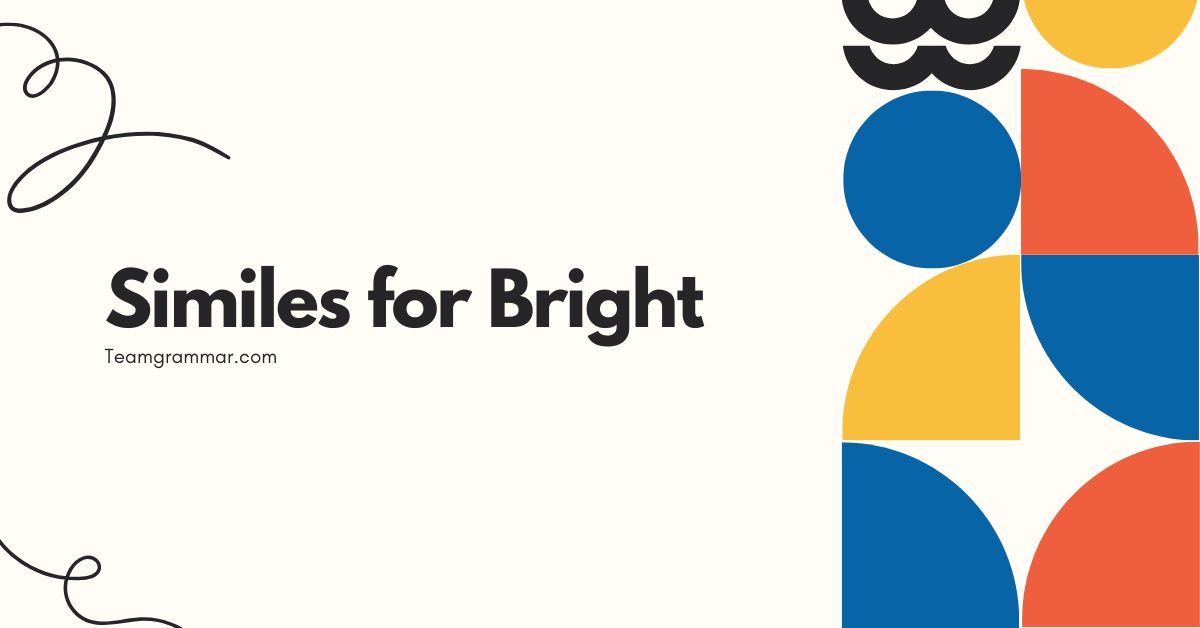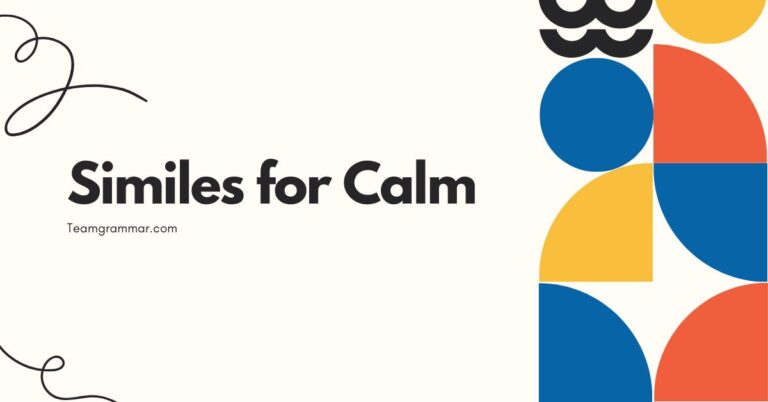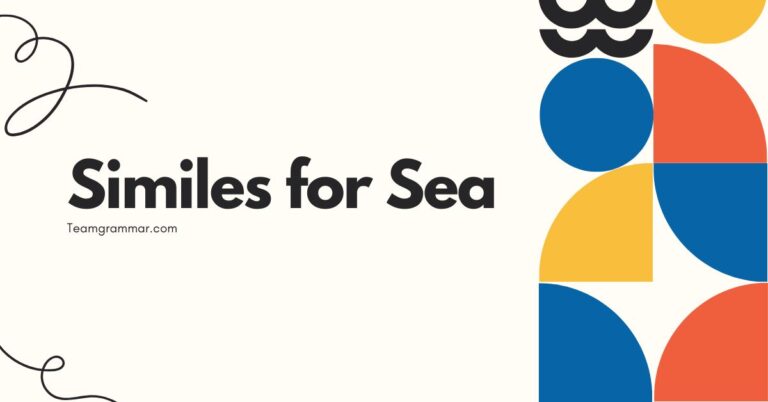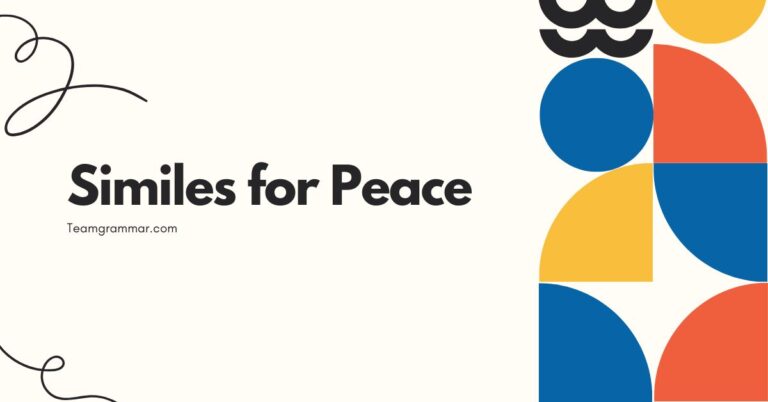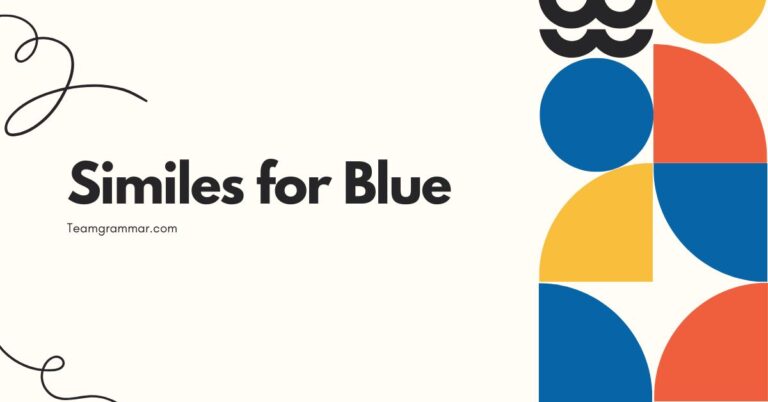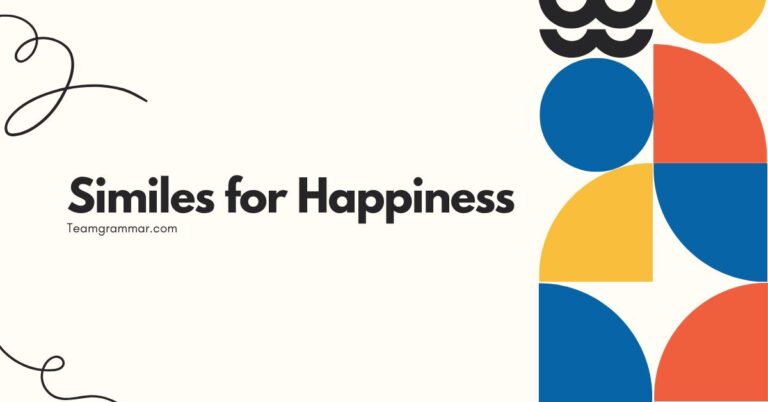43 Similes for Bright: Illuminating Language with Figurative Speech
Similes are powerful tools in the English language, allowing us to paint vivid pictures and create deeper understanding by comparing two unlike things. When describing something as “bright,” similes can add nuance and creativity to your writing.
Mastering the art of crafting effective similes not only enhances your descriptive abilities but also allows you to engage your audience more effectively. This comprehensive guide explores the world of similes for “bright,” providing definitions, examples, usage rules, and practice exercises to help you shine in your writing and communication.
Table of Contents
- Introduction
- Definition of Simile
- Structural Breakdown of Similes
- Types of Similes for “Bright”
- Examples of Similes for “Bright”
- Usage Rules for Similes
- Common Mistakes with Similes
- Practice Exercises
- Advanced Topics in Similes
- Frequently Asked Questions (FAQ)
- Conclusion
Introduction
Language is a vibrant tapestry woven with threads of literal and figurative expression. Among the most effective tools for adding color and depth to our language is the simile.
Similes allow us to draw comparisons, creating vivid images and enhancing understanding. The concept of “brightness” is often used metaphorically and literally, requiring nuanced descriptions.
Understanding and using similes effectively can significantly improve your writing and communication skills, making your language more engaging and impactful.
This article delves into the realm of similes specifically tailored to describe “bright” things. Whether you’re a student, writer, or language enthusiast, this guide will provide you with a comprehensive understanding of how to use similes effectively.
We will explore various types of similes, provide numerous examples, discuss usage rules, and address common mistakes. By the end of this article, you will be well-equipped to incorporate similes into your writing and speech, adding a touch of brilliance to your language.
Definition of Simile
A simile is a figure of speech that directly compares two different things using the words “like” or “as.” Its primary function is to enhance description by creating a vivid image in the reader’s or listener’s mind. Unlike a metaphor, which implies a direct equivalence, a simile acknowledges the difference between the two things being compared while highlighting a shared quality.
Similes are a type of figurative language, which means they use words or expressions with a meaning that is different from the literal interpretation. They add depth and texture to writing, making it more engaging and memorable.
The effectiveness of a simile depends on the clarity and relevance of the comparison. A good simile should resonate with the audience and create a strong mental image.
Classification of Similes
Similes can be classified based on the type of comparison they make. They can compare physical attributes, emotional states, or abstract concepts.
For example, a simile might compare the brightness of a star to the brightness of a diamond, focusing on a physical attribute. Alternatively, it might compare the brightness of a person’s smile to the warmth of the sun, focusing on an emotional or sensory experience.
Furthermore, similes can be categorized by their level of complexity. Some similes are straightforward and easy to understand, while others are more nuanced and require deeper thought.
The choice of simile depends on the context and the desired effect. Simpler similes are suitable for general audiences, while more complex similes can be used to engage readers in more sophisticated literary works.
Function of Similes
The primary function of a simile is to enrich language by providing a fresh perspective on a subject. By comparing something to something else, similes can illuminate hidden qualities or create a more impactful description.
They can also evoke emotions and create a connection with the audience. In essence, similes make language more vibrant and engaging.
Similes are often used in literature, poetry, and everyday conversation. They can add humor, emphasize a point, or simply make language more interesting.
The skillful use of similes can transform a mundane description into a memorable one, making it an essential tool for effective communication.
Contexts for Using Similes
Similes are versatile and can be used in a wide range of contexts. They are commonly found in creative writing, such as novels, short stories, and poems.
In these contexts, similes are used to enhance imagery and create a deeper connection with the reader. They can also be used in persuasive writing to make an argument more compelling or in informative writing to clarify complex concepts.
Beyond writing, similes are also used in everyday conversation. They can add color to your speech and make your communication more engaging.
Whether you’re describing the weather, complimenting someone’s appearance, or explaining a difficult concept, similes can help you express yourself more effectively.
Structural Breakdown of Similes
The structure of a simile is relatively simple, consisting of three main components: the subject being described, the comparison word (“like” or “as”), and the object of comparison. Understanding this structure is crucial for creating effective and grammatically correct similes.
Let’s break down each component in detail.
The Subject
The subject is the thing being described or compared. It is the focal point of the simile.
The subject can be a noun, pronoun, or noun phrase. It should be clear and easily identifiable.
For instance, in the simile “The sun is like a giant spotlight,” the subject is “the sun.”
Choosing the right subject is essential for creating an effective simile. The subject should be something that the audience can easily relate to or understand.
It should also be something that benefits from the comparison, gaining new or enhanced qualities through the simile.
The Comparison Word
The comparison word is the link between the subject and the object of comparison. The two most common comparison words are “like” and “as.” These words indicate that a comparison is being made, rather than a direct equivalence.
While both “like” and “as” can be used interchangeably in many similes, there are subtle differences in their usage.
“Like” is generally used to compare nouns or pronouns, while “as” can be used to compare clauses or phrases. However, this is not a strict rule, and both words can be used in various contexts.
The key is to choose the word that sounds most natural and fits best with the overall structure of the simile.
The Object of Comparison
The object of comparison is the thing that the subject is being compared to. It should share a common quality with the subject, which is the basis of the comparison.
The object of comparison can be a noun, pronoun, or noun phrase. It should be something that is familiar to the audience, so they can easily understand the comparison.
For example, in the simile “Her smile was as bright as the sun,” the object of comparison is “the sun.” The shared quality between her smile and the sun is brightness. The effectiveness of the simile depends on the clarity and relevance of this shared quality.
The object of comparison should enhance the understanding or appreciation of the subject.
Types of Similes for “Bright”
Similes for “bright” can be categorized based on what aspect of brightness they emphasize. This could be the intensity of light, the clarity of color, or the metaphorical sense of intelligence or happiness.
Understanding these categories can help you choose the most appropriate simile for your specific context.
Intensity of Light
These similes focus on the sheer luminosity of something. They often compare the subject to sources of intense light, such as the sun, stars, or artificial lights.
They are used to emphasize how radiant or dazzling something is.
Examples include:
* As bright as the sun
* Like a shining star
* As radiant as a spotlight
Clarity of Color
These similes focus on the vividness and purity of color. They often compare the subject to brightly colored objects, such as gemstones, flowers, or vibrant paints.
They are used to emphasize how striking or eye-catching something is.
Examples include:
* As bright as a ruby
* Like a field of sunflowers
* As vibrant as a rainbow
Metaphorical Brightness
These similes extend the concept of brightness to abstract qualities, such as intelligence, happiness, or hope. They often compare the subject to sources of metaphorical light, such as a brilliant idea, a cheerful smile, or a promising future.
They are used to emphasize how positive or uplifting something is.
Examples include:
* As bright as a new idea
* Like a beacon of hope
* As cheerful as a sunny day
Examples of Similes for “Bright”
To illustrate the different ways similes can be used to describe “bright,” here are several examples categorized by their specific focus. These examples are designed to provide you with a wide range of options for your own writing and speech.
Examples Focusing on Light Intensity
This table provides examples of similes that focus on the intensity of light. These similes are perfect for describing things that are dazzling, radiant, or intensely luminous.
| Simile | Example Sentence |
|---|---|
| As bright as the sun | The stage lights were as bright as the sun, making it hard to see the audience. |
| Like a shining star | Her eyes were like shining stars, twinkling with excitement. |
| As radiant as a spotlight | The diamond ring was as radiant as a spotlight, catching everyone’s attention. |
| Bright like a supernova | The explosion was bright like a supernova, lighting up the entire sky. |
| As bright as day | The room was as bright as day, even though it was the middle of the night. |
| Like a laser beam | The flashlight was as bright as a laser beam, cutting through the darkness. |
| As bright as lightning | The flash of insight was as bright as lightning, illuminating the solution to the problem. |
| Like a lighthouse beam | Her smile was like a lighthouse beam, guiding me through a difficult time. |
| As bright as a flame | His passion burned as bright as a flame, fueling his determination. |
| Like a floodlight | The security lights were as bright as floodlights, deterring any potential intruders. |
| As bright as a welding torch | The arc of the welding torch was as bright as a welding torch, requiring protective gear. |
| Like the noonday sun | Their future looked bright like the noonday sun, full of promise and opportunity. |
| As bright as polished silver | The silverware on the table was as bright as polished silver, gleaming under the chandelier. |
| Like a halogen lamp | The new streetlights shone bright like a halogen lamp, improving visibility at night. |
| As bright as a camera flash | The paparazzi’s cameras flashed as bright as a camera flash, blinding the celebrities. |
| Like a beacon in the night | Her kindness was like a beacon in the night, guiding lost souls back to safety. |
| As bright as the North Star | His unwavering principles were as bright as the North Star, a constant guide in his life. |
| Like a neon sign | The storefront sign was as bright as a neon sign, attracting customers from blocks away. |
| As bright as the moon | The full moon was as bright as the moon, illuminating the landscape below. |
| Like a searchlight | The police helicopter circled overhead, its searchlight bright like a searchlight. |
| As bright as the sun at its zenith | Her confidence shone as bright as the sun at its zenith, unwavering and powerful. |
| Like a thousand points of light | The city skyline was like a thousand points of light, sparkling against the dark sky. |
Examples Focusing on Color Clarity
This table provides examples of similes that focus on the clarity and vividness of color. These similes are ideal for describing things that are striking, vibrant, or visually appealing.
| Simile | Example Sentence |
|---|---|
| As bright as a ruby | The queen’s necklace was as bright as a ruby, catching the light with every movement. |
| Like a field of sunflowers | The garden was like a field of sunflowers, bursting with yellow hues. |
| As vibrant as a rainbow | The children’s artwork was as vibrant as a rainbow, full of color and energy. |
| Bright like a parrot’s feathers | The dancer’s costume was bright like a parrot’s feathers, a dazzling spectacle. |
| As bright as an emerald | Her eyes were as bright as an emerald, shining with intelligence and wit. |
| Like a blooming poppy | Her dress was bright like a blooming poppy, standing out in the crowd. |
| As bright as a peacock’s tail | The tapestry was as bright as a peacock’s tail, a riot of colors and patterns. |
| Like a box of crayons | The playroom was bright like a box of crayons, filled with colorful toys and decorations. |
| As bright as a butterfly’s wings | The stained glass window was as bright as a butterfly’s wings, casting colorful shadows on the floor. |
| Like a tropical fish | His shirt was bright like a tropical fish, a bold statement of his personality. |
| As bright as autumn leaves | The hillside was as bright as autumn leaves, ablaze with reds, oranges, and yellows. |
| Like a painter’s palette | The sunset was like a painter’s palette, blending hues of pink, orange, and purple. |
| As bright as a stained-glass window | The church was as bright as a stained-glass window, with sunlight streaming through the colored panes. |
| Like a bouquet of wildflowers | Her garden was bright like a bouquet of wildflowers, a riot of colors and fragrances. |
| As bright as a fire opal | The gemstone was as bright as a fire opal, shimmering with inner light. |
| Like a kaleidoscope | The fireworks display was like a kaleidoscope, a swirling array of colors and patterns. |
| As bright as a coral reef | The underwater world was as bright as a coral reef, teeming with colorful marine life. |
| Like a field of tulips | The flower festival was bright like a field of tulips, a breathtaking display of floral beauty. |
| As bright as a stained scarf | Her silk scarf was as bright as a stained scarf, adding a pop of color to her outfit. |
| Like a candy store display | The window display was bright like a candy store display, tempting passersby with its colorful treats. |
| As bright as a summer sky | The painting captured the scene as bright as a summer sky, with clear blue hues and fluffy white clouds. |
| Like a prism in sunlight | The crystal chandelier sparkled like a prism in sunlight, casting rainbows across the room. |
Examples Focusing on Metaphorical Brightness
This table provides examples of similes that extend the concept of “bright” to abstract qualities. These similes are useful for describing things that are intelligent, cheerful, hopeful, or positive.
| Simile | Example Sentence |
|---|---|
| As bright as a new idea | Her mind was as bright as a new idea, constantly generating innovative solutions. |
| Like a beacon of hope | His words were like a beacon of hope, inspiring others to persevere through adversity. |
| As cheerful as a sunny day | Her personality was as cheerful as a sunny day, spreading joy to everyone around her. |
| Bright like a child’s laughter | Her spirit was bright like a child’s laughter, innocent and full of delight. |
| As bright as a promising future | Their prospects were as bright as a promising future, filled with potential and opportunity. |
| Like a light at the end of the tunnel | His encouragement was like a light at the end of the tunnel, giving her the strength to keep going. |
| As bright as a clear conscience | Her integrity was as bright as a clear conscience, guiding her actions with honesty and morality. |
| Like a spark of inspiration | The artist’s vision was bright like a spark of inspiration, igniting her creativity. |
| As bright as a brilliant mind | The professor’s lectures were as bright as a brilliant mind, insightful and thought-provoking. |
| Like a ray of sunshine | Her smile was bright like a ray of sunshine, warming the hearts of those around her. |
| As bright as a star student | He was as bright as a star student, always excelling in his studies. |
| Like a guiding star | Her wisdom was like a guiding star, helping others navigate life’s challenges. |
| As bright as a clean slate | He approached the new project as bright as a clean slate, ready to learn and grow. |
| Like a new beginning | Their relationship was bright like a new beginning, full of hope and promise. |
| As bright as a fresh start | She saw the opportunity as bright as a fresh start, a chance to reinvent herself. |
| Like a burst of energy | His enthusiasm was bright like a burst of energy, invigorating the entire team. |
| As bright as a positive attitude | Her outlook on life was as bright as a positive attitude, even in the face of adversity. |
| Like a flash of insight | His understanding of the problem was bright like a flash of insight, quickly grasping the core issues. |
| As bright as a cheerful disposition | Her personality was as bright as a cheerful disposition, making her a joy to be around. |
| Like a sunny disposition | His friendly nature shone bright like a sunny disposition, lifting everyone’s spirits. |
| As bright as an enlightened perspective | Her wisdom shone as bright as an enlightened perspective, offering valuable insights. |
| Like a clear vision | His goals were bright like a clear vision, guiding his actions with purpose and direction. |
Usage Rules for Similes
While similes are a creative tool, there are certain rules to follow to ensure they are used effectively and grammatically correctly. These rules pertain to clarity, relevance, and grammatical structure.
Clarity Rule
A simile should be clear and easy to understand. The comparison should be obvious and the shared quality between the subject and the object of comparison should be readily apparent.
Avoid using obscure or overly complex comparisons that may confuse the audience.
Example:
* Clear: Her smile was as bright as the sun.
* Unclear: Her smile was like a quantum singularity.
Relevance Rule
The comparison should be relevant to the context and the overall message. The simile should enhance the description and add value to the writing or speech.
Avoid using irrelevant or nonsensical comparisons that detract from the message.
Example:
* Relevant: The diamond was as bright as a star, sparkling with brilliance.
* Irrelevant: The diamond was like a loaf of bread.
Grammatical Structure Rule
The simile should be grammatically correct. The subject and the object of comparison should be properly connected using the comparison word (“like” or “as”).
Ensure that the simile fits seamlessly into the sentence and does not disrupt the flow of the writing.
Example:
* Correct: The light was as bright as the sun is.
* Incorrect: The light as bright the sun.
Avoid Cliches
Cliches are overused similes that have lost their impact and originality. While they may be easy to use, they often make your writing sound uninspired and predictable.
Try to avoid cliches and instead create fresh and original similes that will capture the reader’s attention.
Example:
* Cliche: As bright as the sun.
* Original: As bright as a newly forged star.
Common Mistakes with Similes
Even experienced writers can make mistakes when using similes. Being aware of these common errors can help you avoid them and improve the quality of your writing.
Mixing Metaphors and Similes
One common mistake is confusing similes with metaphors. Remember that a simile uses “like” or “as” to make a comparison, while a metaphor implies a direct equivalence.
Mixing the two can create confusing and illogical statements.
Example:*Incorrect:He was like a lion, the king of the jungle. (This mixes a simile with a metaphor)
*Correct:He was like a lion, roaring with confidence.
(Simile)
*Correct:He was a lion, the king of the jungle. (Metaphor)
Using Weak Comparisons
A simile should create a strong and vivid image in the reader’s mind. Using weak or vague comparisons can undermine the effectiveness of the simile and fail to engage the audience.
Example:
* Weak: The light was like a light bulb.
* Strong: The light was like a thousand fireflies dancing in the night.
Overusing Similes
While similes can enhance your writing, overusing them can make it sound forced and unnatural. Use similes sparingly and only when they add significant value to the description.
Too many similes can clutter your writing and distract the reader.
Example:
* Overuse: The day was as bright as the sun, like a shining star, and as cheerful as a sunny day.
* Better: The day was as bright as the sun, filling everyone with cheer.
Practice Exercises
To reinforce your understanding of similes for “bright,” here are several practice exercises. These exercises will help you identify and create effective similes in various contexts.
Exercise 1: Identifying Similes
Identify the similes in the following sentences:
| Question | Answer |
|---|---|
| 1. Her eyes were like shining stars. | like shining stars |
| 2. The room was bright, illuminating everything. | (None – This is a descriptive statement, not a simile) |
| 3. His smile was as bright as the sun. | as bright as the sun |
| 4. The city lights shone brightly. | (None – This is a descriptive statement, not a simile) |
| 5. The diamond was like a beacon in the night. | like a beacon in the night |
| 6. Her mind was as bright as a new idea. | as bright as a new idea |
| 7. The flowers were vibrant, adding color to the garden. | (None – This is a descriptive statement, not a simile) |
| 8. The painting was as vibrant as a rainbow. | as vibrant as a rainbow |
| 9. The future looked promising, filled with hope. | (None – This is a descriptive statement, not a simile) |
| 10. His words were like a light at the end of the tunnel. | like a light at the end of the tunnel |
Exercise 2: Completing Similes
Complete the following similes with an appropriate comparison:
| Question | Answer |
|---|---|
| 1. The lamp was as bright as ____. | the sun |
| 2. Her dress was like ____. | a field of sunflowers |
| 3. His mind was as bright as ____. | a new idea |
| 4. The gem was like ____. | a beacon in the night |
| 5. Her smile was as bright as ____. | a sunny day |
| 6. The explosion was as bright as ____. | lightning |
| 7. His future was like ____. | a promising future |
| 8. The painting was as bright as ____. | a rainbow |
| 9. Her intelligence was as bright as ____. | a brilliant mind |
| 10. The star was like ____. | a shining beacon |
Exercise 3: Creating Similes
Create your own similes for the following subjects, using “bright”:
| Subject | Possible Simile |
|---|---|
| A child’s eyes | Her eyes were as bright as a child’s on Christmas morning. |
| A gemstone | The gemstone was as bright as a newly polished diamond. |
| A sunny day | The day was as bright as a sunny day in July. |
| An idea | The idea was as bright as a lightbulb suddenly illuminating. |
| A smile | Her smile was as bright as a ray of sunshine. |
| A star | The star was as bright as a distant sun. |
| A flame | The flame burned as bright as a beacon in the dark. |
| A room | The room was as bright as a photographer’s studio. |
| A personality | Her personality was as bright as a summer’s day. |
| A future | Their future was as bright as a clear sky after a storm. |
Advanced Topics in Similes
For advanced learners, there are more complex aspects of similes to explore, including extended similes and the use of similes in different genres and styles.
Extended Similes
An extended simile is a simile that is developed over several sentences or even paragraphs. It allows for a more detailed and nuanced comparison, creating a richer and more immersive experience for the reader.
Extended similes are often used in literary works to create vivid imagery and enhance the emotional impact of the writing.
Example:”Her mind was like a vast and intricate library, filled with countless books on every subject imaginable. Each book represented a different piece of knowledge or experience, carefully cataloged and readily accessible.
When faced with a problem, she could effortlessly browse through her mental library, drawing on the wisdom and insights of countless authors and thinkers to find a solution.”
Similes in Different Genres
The use of similes can vary depending on the genre and style of writing. In poetry, similes are often used to create lyrical and evocative descriptions.
In fiction, they can be used to develop characters, create atmosphere, and advance the plot. In non-fiction, they can be used to clarify complex concepts and make the writing more engaging.
For example, in scientific writing, similes can be used to explain abstract concepts by comparing them to familiar objects or phenomena. In persuasive writing, they can be used to make an argument more compelling by appealing to the reader’s emotions and imagination.
Frequently Asked Questions (FAQ)
Here are some frequently asked questions about similes, along with detailed answers to help you deepen your understanding.
- What is the difference between a simile and a metaphor?
A simile is a comparison using “like” or “as,” while a metaphor implies direct equivalence without these words. Similes acknowledge a difference while highlighting a similarity; metaphors assert that one thing *is* another.
- Can I use similes in formal writing?
Yes, but use them judiciously. In formal writing, similes should enhance clarity and understanding, not merely add embellishment. Ensure they are appropriate for the tone and audience.
- How can I make my similes more original?
Avoid cliches and think outside the box. Consider unusual or unexpected comparisons that still make sense and create a vivid image. Focus on specific details and sensory experiences.
- Is it okay to use similes in everyday conversation?
Absolutely! Similes can make your conversations more engaging and expressive. Just be mindful of your audience and choose comparisons that are appropriate and easily understood.
- What if my simile doesn’t make sense to others?
Clarity is key. If your simile isn’t resonating, reconsider your comparison. Ensure the shared quality between the subject and object is apparent and relevant to your audience’s understanding.
- How do I avoid using clichéd similes?
The best way to avoid clichéd similes is to think creatively and try to find unique and unexpected comparisons. Instead of saying “as bright as the sun,” which is a very common simile, you could try something like “as bright as a freshly forged star” or “as bright as a supernova explosion.”
- Can a simile be too complex?
Yes, a simile can be too complex if it is difficult for the reader to understand the comparison being made. The goal of a simile is to enhance understanding and create a vivid image, so if the simile is too convoluted or obscure, it will not be effective.
- What are some common mistakes to avoid when writing similes?
Some common mistakes to avoid include using clichéd similes, mixing metaphors and similes, using weak comparisons, and overusing similes. It’s also important to ensure that your similes are grammatically correct and relevant to the context.
- Are there any specific types of words that work best in similes?
Nouns and adjectives are commonly used in similes because they help to create vivid and descriptive comparisons. However, you can also use verbs and adverbs, depending on the specific comparison you want to make.
- How can I practice writing better similes?
Practice by observing the world around you and noting similarities between different things. Experiment with different comparisons and ask for feedback from others to see if your similes are clear and effective. Reading widely and paying attention to how other writers use similes can also be helpful.
Conclusion
Mastering the art of using similes for “bright” can significantly enhance your writing and communication skills. By understanding the definition, structure, types, and usage rules of similes, you can create vivid and engaging descriptions that capture the reader’s attention.
Remember to avoid common mistakes
and strive for clarity, relevance, and originality in your comparisons.
Whether you’re describing the intensity of light, the clarity of color, or the metaphorical sense of brightness, similes can add depth and texture to your language. Practice the exercises provided in this guide and continue to explore the creative possibilities of similes.
With dedication and practice, you’ll be able to illuminate your writing with the brilliance of well-crafted similes, making your words shine brightly.

